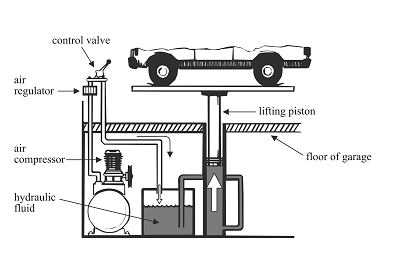Level 6 Applied Technology
The garage where you work is equipped with a hydraulic lift, like the one shown, that you use to raise cars off the floor so it is easier to service them. An air compressor capable of generating pressures of 120 pounds per square inch (psi) powers the lift. The air regulator releases a steady amount of air pressure (usually 30 to 40 psi), and the control valve directs the flow of that air through the lines. Pushing the control valve forward (as shown in the figure) allows air into the lines, raising the lift. Moving the valve to the middle position seals the line so no air can escape, and pulling the valve back releases air from the line, lowering the lift. The air from the compressor exerts a force on a tank of hydraulic fluid which, in turn, transmits this force to the bottom of the lifting piston.

*Figure adapted from Principles of Technology Teacher's Guide, Year 1, Unit 7, Force Transformers (Waco, TX: Center for Occupational Research and Development, 1991), 94. Used with permission.
You have been working on a car up on the lift for about an hour. When you raised the car, the lift worked normally, but now the lifting piston has begun to creep down. You check the control valve, and it is fine. Also, there is no hydraulic fluid on the garage floor or in the lift pit below the garage floor.
Why this is a Level 6 item:
- The problem involves one complex system with multiple interacting components (air compressor, regulator, valve, piston, and hydraulic fluid).
- The problem involves many variables at the same time (regulator, valve, piston, and compressor).
- Examinees must understand the operation of a complex system (the hydraulic lift).
- Examinees must use less obvious clues to find the source of a problem (the lifting piston has begun creeping down but there is no evidence of hydraulic fluid).
- The problem uses illustrations to help show the meaning of technical terms (hydraulic lift, air regulator, control valve).
- Examinees must apply the principles of two or more areas of technology (fluids and mechanics) as they interact in complex systems.
- Examinees must test possible hypotheses to ensure the problem is diagnosed correctly.
-
4.
The next thing you should check to determine the problem is the: